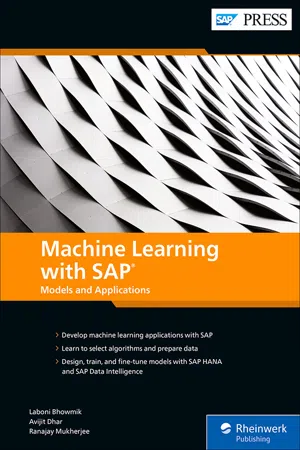
Machine Learning with SAP
Models and Applications
- 495 pages
- English
- ePUB (mobile friendly)
- Available on iOS & Android
About this book
Work smarter with machine learning! Begin with core machine learning concepts—types of learning, algorithms, data preparation, and more. Then use SAP Data Intelligence, SAP HANA, and other technologies to create your own machine learning applications. Master the SAP HANA Predictive Analysis Library (PAL) and machine learning functional and business services to train and deploy models. Finally, see machine learning in action in industries from manufacturing to banking. a. Foundation
Build your understanding of probability concepts and algorithms that drive machine learning. See how linear regression, classification, and cluster analysis algorithms work, before plugging them into your very own machine learning app!
b. Development
Follow step-by-step instructions to gather and prepare data, create machine learning models, train and fine-tune models, and deploy your final app, all using SAP HANA and SAP Data Intelligence.
c. Platforms
Use built-in SAP HANA libraries to create applications that consume machine learning algorithms or integrate with the R language for additional statistical capabilities. Work with the SAP Leonardo functional services to customize and embed pre-trained models into applications or bring your own model with the help of Google TensorFlow. 1) Development
2) Retraining
3) Implementation
4) SAP Data Intelligence
5) SAP HANA predictive analysis library
6) SAP HANA extended machine learning library
7) SAP HANA automated predictive library
8) Google TensorFlow
9) Embedded machine learning
10) SAP Conversational AI
11) SAP Analytics Cloud Smart Predict
Frequently asked questions
- Essential is ideal for learners and professionals who enjoy exploring a wide range of subjects. Access the Essential Library with 800,000+ trusted titles and best-sellers across business, personal growth, and the humanities. Includes unlimited reading time and Standard Read Aloud voice.
- Complete: Perfect for advanced learners and researchers needing full, unrestricted access. Unlock 1.4M+ books across hundreds of subjects, including academic and specialized titles. The Complete Plan also includes advanced features like Premium Read Aloud and Research Assistant.
Please note we cannot support devices running on iOS 13 and Android 7 or earlier. Learn more about using the app.
Information
Part I
1 Machine Learning and Intelligent Enterprise
- 1960s–1980s, mainframe and personal computers
An automation revolution driven by the innovation of transistors and silicon chips along with emergence of large-scale mainframe system and personal computers. - 1990s–2000s, client server and internet
Demonstrated widespread adoption of personal computers, broadband internet, rise of enterprise resource planning (ERP) systems and process-oriented technologies. - 2000s–2010s, cloud, mobile, and big data
Digital transformation, it’s all about smartphones, cloud computing, social networks, and big data. - 2010s–2020s, intelligent technolog ies
Taking advantage of technological advancements in the areas of machine learning, artificial intelligence, Internet of Things, blockchain, and advance analytics including prediction.

- People can work seamlessly and access any systems from any device at any time.
- Systems are capable of prioritizing work for people.
- Solutions for dealing with business problems are proposed.
- Repetitive and time-consuming tasks are performed in an automated fashion.
- Systems can discover new patterns and insights from business data during processing, learning from this data to make smarter decisions at the right times.
1.1 What Is Machine Learning?
1.2 Transition from the Digital Era to the Intelligent Era
Table of contents
- Dear Reader
- Notes on Usage
- Table of Contents
- Preface
- Part I Introduction
- 1 Machine Learning and Intelligent Enterprise
- 2 Machine Learning Fundamentals
- 3 Implementation Lifecycle
- 4 Machine Learning on SAP HANA
- 5 Machine Learning with SAP Data Intelligence
- Part II Building Machine Learning Applications
- 6 SAP HANA Predictive Analysis Library
- 7 Developing Applications with SAP HANA Predictive Analysis Library
- 8 SAP AI Business Services
- 9 Building Scenarios Using Jupyter Notebook
- 10 Automated Machine Learning Data Science Automation
- 11 Conversational Artificial Intelligence
- Part III Use Cases and Roadmaps
- 12 Integrating Machine Learning with the Internet of Things
- 13 Industry Use Cases for Machine Learning Applications
- 14 Conclusion and Roadmap
- The Authors
- Index
- Service Pages
- Legal Notes